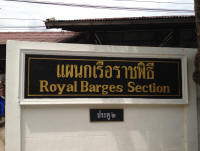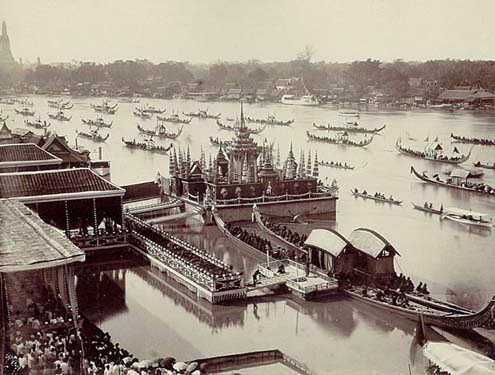Royal Barge Procession on the River
• Frequency: Rare ceremonial occasions (typically once every few years)
• Purpose: Royal ceremonies, particularly the Kathin robe-offering ceremony
• Scale: 52 magnificent barges with over 2,000 oarsmen
• Duration: Approximately 3-4 hours for the complete procession
The Royal Barge Procession represents one of Thailand's most spectacular and historically significant ceremonial traditions, combining centuries-old royal protocol with breathtaking displays of Thai craftsmanship and cultural heritage. On these extraordinary occasions, His Majesty the King or his representative travels along the sacred waters of the Chao Phraya River in magnificently decorated royal barges to perform Buddhist ceremonies, most notably the presentation of new robes to monks at Wat Arun (Temple of the Dawn) during the Kathin season.
This ancient ceremony traces its roots back over 700 years to the Sukhothai period, evolving through the Ayutthaya Kingdom and continuing into the modern Chakri Dynasty. The procession serves multiple purposes: honoring Buddhist traditions, demonstrating royal devotion to the faith, and preserving Thailand's maritime cultural heritage for future generations.
The Magnificent Fleet of Royal Barges
The royal fleet consists of 52 meticulously crafted vessels, each representing centuries of Thai artistic tradition and spiritual symbolism. These floating masterpieces are not merely transportation—they embody Thailand's rich cultural identity and the profound connection between the monarchy, Buddhism, and the Chao Phraya River that has sustained Thai civilization.
• Suphannahong: The golden swan barge, most sacred vessel carrying the King
• Anantanakkharat: The great naga serpent barge for royal family members
• Anekkachatphutchong: Multi-tiered vessel for royal regalia and offerings
• Krut Hern Het: Garuda barge featuring the mythical bird of Vishnu
All the barges in the procession are extraordinary works of art decorated in traditional Thai fashion, but it is the principal Royal Barge, Suphannahong (Golden Swan), which serves as the ceremonial highlight. This magnificent vessel, symbolically crafted in the shape of a mythical golden swan, represents purity, grace, and spiritual transcendence in Thai Buddhist cosmology. The barge's intricate decorations feature colored glass mosaics, gold leaf applications, and traditional Thai artistic motifs that have been lovingly maintained by master craftsmen for generations.
The Spectacular Ceremonial Procession
When the procession occurs—typically at dusk to maximize the visual impact of illuminated decorations—it creates an unforgettable spectacle that transforms the Chao Phraya River into a flowing tableau of Thai cultural heritage. The sight of 52 magnificent barges gliding silently down the river, powered by over 2,000 expertly trained oarsmen dressed in traditional royal livery, represents one of the world's most impressive displays of coordinated pageantry and cultural preservation.
• Starting Point: Wasukri Royal Landing Place in Khet Dusit
• Route: Down the Chao Phraya River to Wat Arun
• Participants: Over 2,000 specially trained royal naval officers
• Formation: Precise ceremonial arrangement with 51 historic barges plus one modern vessel
The procession begins at the historic Wasukri Royal Landing Place in Khet Dusit, where the royal barges are ceremonially launched with traditional Buddhist blessings and ancient protocols. Each of the 2,000+ oarsmen has undergone months of rigorous training to achieve the precise synchronization required for this magnificent display. Their coordinated rowing creates a mesmerizing rhythm that echoes across the water, while the gentle splash of oars provides a meditative soundtrack to this moving meditation on Thai cultural continuity.
The newest barge in the fleet was commissioned in 1994 by order of His Majesty King Bhumibol Adulyadej (Rama IX), demonstrating the monarchy's commitment to preserving and extending this ancient tradition into the modern era. This contemporary addition maintains the same exacting standards of craftsmanship and symbolic significance as the historic vessels, ensuring that the Royal Barge Procession remains a living tradition rather than merely a historical artifact.
Cultural and Spiritual Significance
Beyond its visual splendor, the Royal Barge Procession serves profound spiritual and cultural purposes deeply rooted in Thai Buddhist traditions. The Kathin ceremony, during which new robes are presented to monks, represents one of Buddhism's most significant merit-making opportunities. When the King participates in this ceremony via the royal barges, it demonstrates the monarchy's role as protector and patron of Buddhism, reinforcing the spiritual foundation of Thai society.
• Merit-making: Royal participation in Kathin ceremony generates spiritual merit for the nation
• Unity: Demonstrates harmony between monarchy, Buddhism, and Thai people
• Continuity: Links contemporary Thailand to 700+ years of royal-Buddhist traditions
• Cultural pride: Showcases Thailand's unique artistic and maritime heritage
The symbolic elements embedded within each barge reflect Thailand's complex spiritual cosmology, blending Hindu-Buddhist mythology with indigenous beliefs and royal iconography. The golden swan (Hamsa) represents divine knowledge and spiritual purity, while the naga serpents symbolize protection and the life-giving power of water. These mythological references connect the ceremony to ancient Southeast Asian spiritual traditions while affirming the monarchy's divine mandate to protect and preserve Thai culture.
National Museum of Royal Barges

• Location: Bangkok Noi Canal, near Phra Pin-klao Bridge
• Hours: Daily 9:00 AM - 5:00 PM
• Admission: THB 100 for foreign visitors (2025 pricing)
• Duration: Allow 1-2 hours for comprehensive visit
During the years when there is no Royal Barge Procession, visitors can still experience the magnificence of these floating masterpieces at the National Museum of Royal Barges, one of Bangkok's most unique and culturally significant attractions. This specialized museum houses the complete collection of royal vessels, allowing visitors to examine up close the intricate craftsmanship and symbolic details that make each barge a work of art.
All four major Royal Barges are on permanent display within the museum's specially designed pavilions, along with numerous supporting vessels and historical artifacts related to Thailand's royal maritime traditions. The museum provides detailed explanations of each barge's historical significance, construction techniques, and ceremonial roles, offering visitors deep insights into Thai royal culture and Buddhist traditions.
• Suphannahong Golden Swan: The principal royal barge in all its golden glory
• Detailed craftsmanship: Close-up views of intricate decorative work
• Historical artifacts: Royal regalia, traditional naval uniforms, and ceremonial items
• Educational displays: Detailed explanations of Buddhist symbolism and royal protocols
The museum building itself reflects traditional Thai architectural principles while providing modern climate control and lighting to preserve these priceless cultural treasures. Visitors can walk around each barge, appreciating the masterful woodcarving, gold leaf application, and glass mosaic work that represents the pinnacle of Thai decorative arts. Interactive displays explain the symbolic meaning of various decorative elements and their significance in Thai Buddhist cosmology.
Experiencing Royal Barge Heritage Today
For visitors unable to witness an actual Royal Barge Procession—which occurs only on the rarest ceremonial occasions—the museum provides the most comprehensive way to understand and appreciate this extraordinary aspect of Thai cultural heritage. The peaceful setting along Bangkok Noi Canal also offers visitors a glimpse into traditional Thai life away from the bustling city center.
• Photography: Allowed inside museum (check current policy for flash restrictions)
• Best time: Morning visits avoid afternoon heat and crowds
• Accessibility: Wheelchair accessible pathways throughout museum
• Combined visit: Easy to combine with nearby Wat Rakang temple visit
The museum's location on Bangkok Noi Canal provides convenient access via both land and water transportation. Visitors can reach the museum by taxi from central Bangkok (approximately 30-45 minutes depending on traffic) or combine their visit with a canal tour to experience the traditional waterway setting that has been home to these magnificent vessels for centuries.

Historical Timeline and Future Preservation
The Royal Barge tradition represents an unbroken chain of cultural continuity spanning multiple Thai kingdoms and royal dynasties. From the ancient Sukhothai period through the golden age of Ayutthaya, the destruction and rebuilding following the Burmese invasions, and the establishment of the current Chakri Dynasty in Bangkok, these magnificent vessels have served as floating symbols of Thai sovereignty and spiritual devotion.
Today's preservation efforts ensure that future generations will continue to witness this extraordinary cultural heritage. Master craftsmen trained in traditional techniques maintain and restore the historic barges, while new apprentices learn the ancient arts of Thai decorative woodcarving, gold leaf application, and traditional boat building. This commitment to cultural preservation demonstrates Thailand's dedication to maintaining its unique identity in an increasingly globalized world.
For comprehensive information about visiting Bangkok's riverside temples and cultural attractions, including planning your visit around potential royal ceremonies, explore our complete temples and cultural heritage guide.


